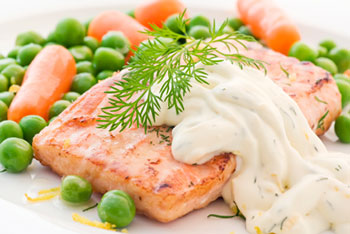It's easy to get answers about health and nutrition! Just send your question by email to [email protected] and Dr. Harlan will respond to selected questions of general interest. Answers will be posted in the Ask Dr. Gourmet newsletter (sign up now!) and archived in the Ask Dr. Gourmet section of the website.
Please note that the Ask Dr. Gourmet feature is restricted to questions regarding food and nutrition. Due to the many questions we receive, not all questions may be answered. For more specific questions about your individual health, please contact your doctor. About Timothy S. Harlan, MD, FACP, CCMS | Terms of Use | Privacy Policy
Ask Dr. Gourmet
Why are recipes that don't contain high-Vitamin-K ingredients unsafe for Coumadin users?
Why would the Salmon with Caper Mayonnaise or the Iceberg Wedge Salad with Blue Cheese Dressing or the Cumin, Black Eyes and Corn Salad not be safe for Coumadin users? I have your book, Vitamin K Levels in Common Foods and most of those foods are listed as acceptable in reasonable quantities. I have wondered this same thing about a few other recipes you have published as I have perused the list of ingredients and not seen big red flags. This is what is so confusing about being a person taking warfarin - it seems there is a different slant on the same foods fairly often. Thank you for your response to a question that I suspect many people would like to have answered. I enjoy your books and your information on the internet and always appreciate your input.
Dr. Gourmet Says...

The difference lies in the cumulative amounts of Vitamin K in the recipe. A recipe might not contain foods that by themselves are considered high in Vitamin K - or "big red flags" as you say - but put three medium level ingredients into the recipe together and they might be what we would consider too high. We here at Dr. Gourmet look at the total micrograms of Vitamin K in a recipe - not only which ingredients it contains. That's why we have recipes that contain "red flag" ingredients like spinach or broccoli that can still be labeled "safe for Coumadin users."
Here's how we decide whether to label a recipe as not safe for Coumadin users, and I'll admit it's somewhat arbitrary because little research exists for the optimum Vitamin K intake in those using warfarin.
First, we start with what the recommended daily allowance (RDA) of daily Vitamin K of about 76-80 micrograms per day. We consider that a good guideline is about 25-30 micrograms per meal (figuring three meals a day). Since for many people the largest meal of their day is their evening meal, we've allotted 35 micrograms for an evening meal that is a complete meal of protein, starch, and vegetable (remember that a salad can be a complete meal!).
A main course protein alone (like a steak recipe, for example) is considered safe under 30 micrograms although proteins alone are usually far lower than that.
Vegetable side dishes are considered safe under 25 micrograms. Starch side dishes also have a 25 microgram cut-off, although again, usually starches alone are much lower than that. Breakfast and lunch meals also come under of 25 micrograms.
Obviously this is not going to yield a perfect 80 micrograms per day each and every day. But in practice it does keep one's intake of Vitamin K fairly consistent - and that's the goal of watching your Vitamin K intake. Research has shown that consuming a consistent amount of Vitamin K is important and will help keep INRs stable.
One thing you're probably wondering is whether you could have a meal containing, say, 60 mcg of Vitamin K as long as your other meals that day were very low in Vitamin K. The answer is Yes - but most people are not going to count micrograms the way they count calories. That's why we state whether the recipe would be considered safe or not - so that those who want a simple Yes or No answer can find recipes that they will feel comfortable eating without knowing the nitty-gritty of the number of micrograms of Vitamin K in a quarter-cup of broccoli.
For those who are so inclined, however, we provide the exact number of micrograms of Vitamin K the recipe contains in its Nutrition Information.
Thanks so much for writing and asking such an important question.
Timothy S. Harlan, MD, FACP, CCMS
Dr. Gourmet
